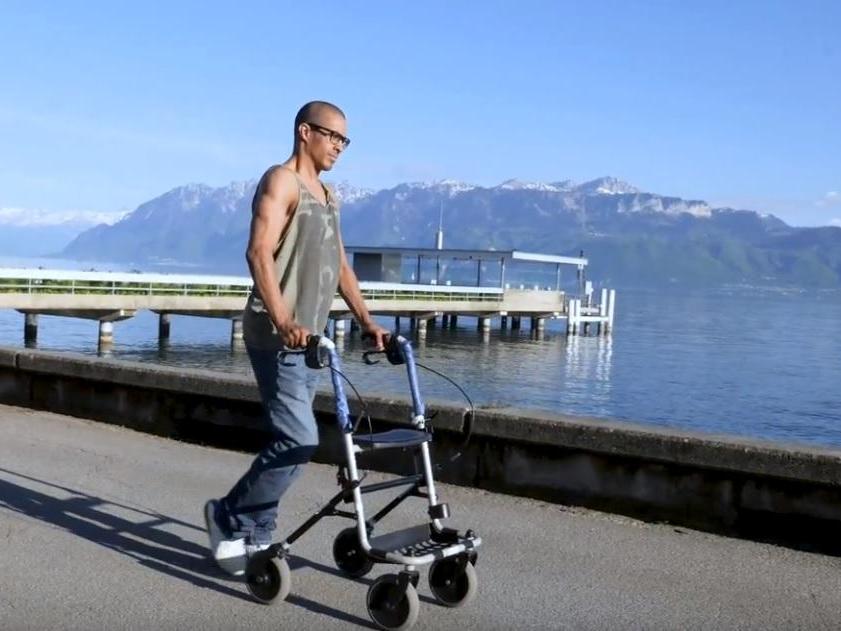The Independent's journalism is supported by our readers. When you purchase through links on our site, we may earn commission.
Paralysed patients able to walk again as 'breakthrough' implant restores nerves in spine
First time patients have regained leg movement and some ability to walk even when implant is turned off, Swiss researchers find
Your support helps us to tell the story
From reproductive rights to climate change to Big Tech, The Independent is on the ground when the story is developing. Whether it's investigating the financials of Elon Musk's pro-Trump PAC or producing our latest documentary, 'The A Word', which shines a light on the American women fighting for reproductive rights, we know how important it is to parse out the facts from the messaging.
At such a critical moment in US history, we need reporters on the ground. Your donation allows us to keep sending journalists to speak to both sides of the story.
The Independent is trusted by Americans across the entire political spectrum. And unlike many other quality news outlets, we choose not to lock Americans out of our reporting and analysis with paywalls. We believe quality journalism should be available to everyone, paid for by those who can afford it.
Your support makes all the difference.Patients restricted to wheelchairs for years have been able to walk entirely unaided thanks to implants which help regenerate and remap nerves in their damaged spines.
The treatment, which has been hailed as a “significant breakthrough” for paralysis sufferers, uses a surgically implanted array of electrodes mapped precisely to the spinal cord, in combination with a unit that sends electrical pulses in response to patients’ intended leg movements.
All three paraplegic individuals who took part in the Swiss study recovered voluntary control of their leg muscles and were able to walk with some weight assistance, or a frame, while the electrical stimulation was active.
But the most important breakthrough is that after five months of training participants were able to move their legs, and in some cases take steps unsupported, even when the implant was switched off.
In recent years a few groups have managed to let patients take steps with electrical stimulation, and a pair of papers in September showed it was possible to restore walking with a mind-controlled implant.
But according to Dr Grégoire Courtine, a neuroscientist from Ecole Polytechnique Fédérale de Lausanne (EPFL) and lead author of the study on the treatment, dubbed Stimo, no one had been able to sustain these improvements without the stimulus.
“The exact timing and location of the electrical stimulation are crucial to a patient’s ability to produce an intended movement,” Dr Courtine said.
His team have refined the process by precisely mapping the placement of electrodes on the spine, and the bursts of electrical impulses, to prevent conflict between the impulses and signals from the legs. This actually promotes the brain’s remapping of the remaining nerves.
“We stimulate the spine as the brain would do, which is much more natural for our participants,” Dr Courtine said at a press conference ahead of the study’s publication in the journals Nature and Nature Neuroscience.
“Within a few days or a week they were able to make the stepping motion after these parts of the brain had been dormant for many years.
“After several months of training with electrical stimulation, our three participants were able to activate their previously paralysed muscles without electrical stimulation. They could even take a few steps overground, hands-free, without any support.
“But it still worked a lot better with the electrical stimulation.”
Gert-Jan Oskam, 35, was in a traffic accident while cycling in China in 2011 and was unable to walk or lift his legs despite intensive therapy.
“The doctors told me that I would never be able to walk again,” he said. “Now I can walk short distances with the help of electrical stimulation and crutches, and even without electrical stimulation. My muscle strength has improved substantially.”

David Mzee, 28, a fellow participant in the study who was injured in a sporting accident in 2010 that left him with limited right leg movement, was able to walk without any assistance – from the implant or walking frame.
Patients who had the most severe spinal damage recovered the least in the trial period, although they are expecting further improvements.
“The next step is to start earlier, just after the injury, when the potential of recovery is much larger,” said neurosurgeon Dr Jocelyne Bloch, from the Lausanne University Hospital, who mapped the electrodes to the parts of the spine which control each muscle group in the legs.
Professor Catherina Becker, who works on spinal cord regeneration at the University of Edinburgh and was not involved with the study, said the results “do indeed look like a significant breakthrough”.
“Patients had been paralysed for years and were now able to walk. It remains to be seen whether the recovery persists for longer times after the stimulation has been turned off, but this is a hugely promising step forward.”
Professor Robe Kaspa,from the University of Melbourne, said: “It is important to note that all spinal cord injuries are different and it is highly likely that not all injuries will respond with equal levels of success.
“Nevertheless, this work presents a significant step towards establishing a viable approach towards restored function in at least a proportion of people with spinal cord injuries who would otherwise face long-term confinement in a wheelchair.”

Join our commenting forum
Join thought-provoking conversations, follow other Independent readers and see their replies
Comments